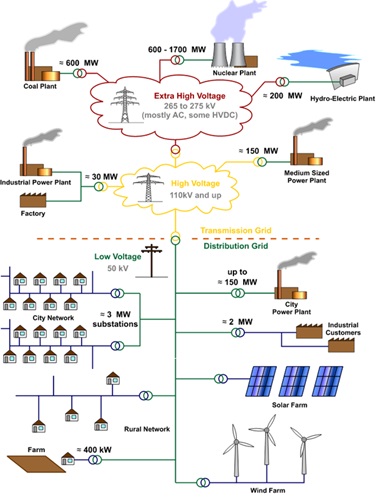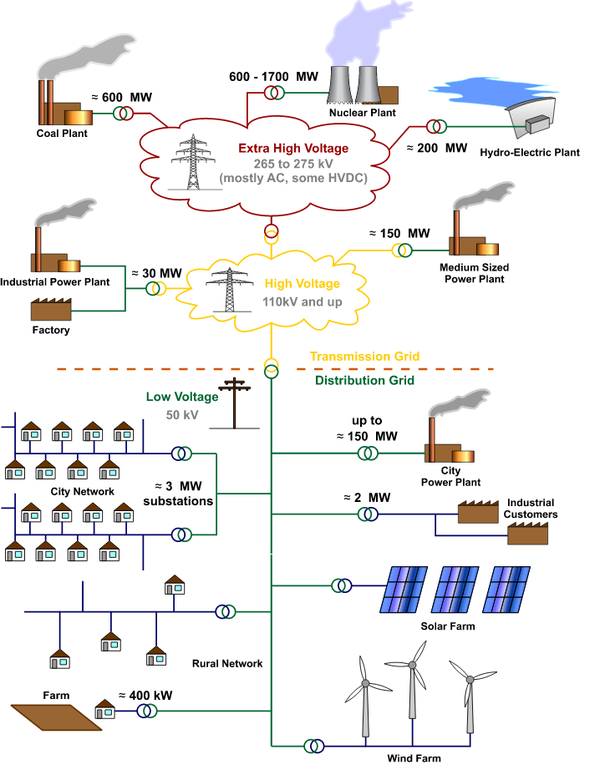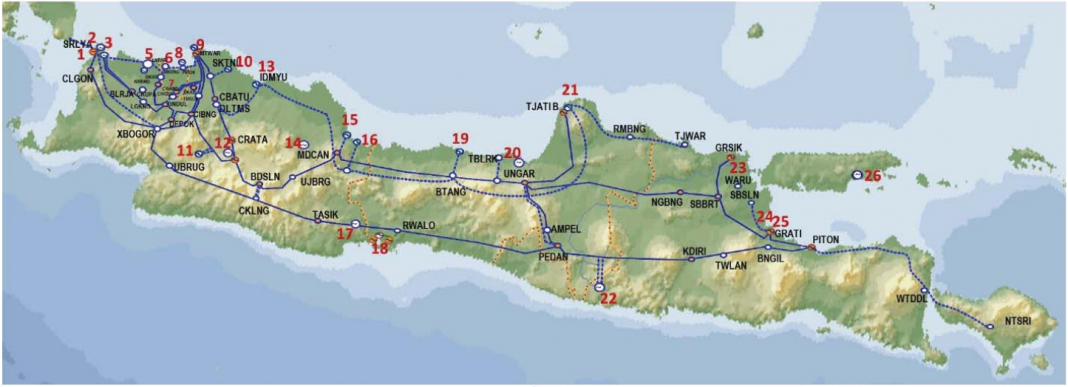Sunday, 4 August 2019, a part of Java experienced an 8 hours power outage, including Jakarta, the capital of Republic of Indonesia. Approximately more than 100 million people affected by the blackout which occurred in many areas across West Java, Banten and Greater Jakarta. The incident can be considered as a major electricity outage, as they conform to these three criteria: 1) The service provider cannot have planned the outage. 2) At least 1,000 people must be affected, and it must last at least one hour. 3) There must be at least 1,000,000 person-hours of disruption (Originenergy, 2018). Following the incident, the state-owned electricity company (PT PLN) gave a statement that the blackout was caused by trips (errors) on the Suralaya turbine gas from number 1 to 6, while the turbine gas number 7 was off. In addition, there was also disruption on Cilegon turbine gas power plants in Banten. However, later that day, PT PLN stated that the cause of the blackout was from a disruption in the 500 kV extra high-voltage power line (SUTET) Transmission of Unggaran and Pemalang. As a result, power outages occurred in a number of areas such as Bandung, Bekasi, Cianjur, Cimahi, Cirebon, Garut, Karawang, Purwakarta, Majalaya, Sumedang, Tasikmalaya, Depok, Gunung Putri, Sukabumi and Bogor (Ramadhan, 2019).

Figure 1. The basic concept of an electrical grid (Electrical grid, 2019).
In order to understand the cause of this incident, we will take a look at the basic concept of the electricity system, illustrated in Figure 1. In the electricity sector, there is a system intended for supplying electricity to the customers, which is called an electrical grid. The electrical grid consists of three main components, namely generation, transmission, and distribution. Generation is where the electricity produced, for instance, in coal-fired power plant, gas turbine power plant, solar power plant and many more. Transmission is the stage when the electricity is transported from the power plant with high voltage by the use of power lines. Lastly, the distribution intended to transform the high voltage electricity from the transmission to lower voltage electricity for the customers uses (Brain, 2001).
The electrification system in Java – Bali area is an interconnected grid with the major power supply comes from East Java for low-cost electricity efficiency. There are two electricity systems in Java – Bali, namely north and south system with two circuits each. On 4 August 2019, there was a disruption on the north circuits system at 11.48 AM Western Indonesian Time. Therefore, the power transfer from east to west was automatically rerouted to the south circuit. At the same time, PT PLN performed routine maintenance on one of the south circuits, as a result only one circuit left for the power transfer. The rerouted power transfer from north to the last functioning line in the south caused a trip and consequently, broke the power transfer from east to west and caused the massive power outage in Greater Jakarta, West Java and Banten (Saptono, 2019).

Figure 2. Java-Bali electricity transmission map (blue line: existing transmission and dashed line: planned transmission) (PT PLN (Persero), 2019).
The power outage lasted differently in each area, averaging around eight to nine hours and caused a citywide disorder. The blackout did not only affect millions of houses but also caused disruptions in mobile networks, transportation, and huge commercial losses for businesses. The Minister of Communication and Informatics, Rudiantara estimated that telecommunication operators lost more than Rp 100 billion due to the power outage. This projection came from the total numbers and duration of the non-active Base Transceiver Station (BTS) during the blackout (Prihadi, 2019).
In the transportation sector, the blackout suspended the operation of the subway line (MRT) and commuter train. The MRT and commuter train use electricity from PT PLN to operate daily, without any backup power, resulting in a sudden disruption when the blackout occurred on Sunday noon. Moreover, it was reported that there were passengers of the MRT stranded and evacuated from underground during the massive blackout. When the power went out, seven train lines were running, and three of them were in underground tunnels. PT Mass Rapid Transit (MRT) also experienced a 13% reduction in customer the day after the blackout and projected Rp 507 million financial loss because of this incident. This number was the outcome due to the MRT was unable to operate and transport more than 50,000 passengers that day (Afifa, 2019).
Moreover, the massive blackout also cancelled the operation of more than 240 commuter lines and made them unable to transport 808,336 passengers, the typical number of commuter line user per day on the weekend (Suryarandika, 2019). Besides, many traffic lights and toll gates also went out and caused many traffic jams all around Jakarta. Restaurants and supermarkets also experienced a severe loss as their products, especially edibles, could not be stored properly and became spoiled.
Indonesia should have been prepared for this kind of incident because it was not the first time a massive power outage occurred in Indonesia. In 2005, all of Java and Bali experienced a massive power outage due to a similar cause, the failure of the 500 kV SUTET. There are also other cases that we could refer as a point of learning to avoid a similar incident in the future, for example, the blackout in India, and United States of America and Canada. The India power outage in 2012 is the largest blackout recorded ever, with approximately 670 million people affected (Xue & Xiao, 2013). And, the northeast blackout in 2003 affected around 50 million people across the United States of America (USA) and Canada (Apt, Lave, Talukdar, Morgan, & Ilic, 2004).
In 2003, part of the USA and Canada were experiencing a massive blackout. Shortly after the incident, the government formed a joint task force to identify the cause of the incident. Their findings showed that the incident began with the failure of one generator and a trip of one sagged overheated power lines, which brushed against some overgrown trees. Then, several power lines were overstressed due to both of the generator and the power line were out of commission, led to more failures and resulting in the massive blackout (Apt, Lave, Talukdar, Morgan, & Ilic, 2004). However, one of the main reasons it escalated to such a massive scale was due to human error. One generator near Cleveland was overworked by the plant operator, exceeded its limit and caused an automatic shutdown. Also, the utility underestimated the seriousness of the situation because it did not perform a contingency analysis to inspect the possible other failures and their impacts.
Moving forward to nine years later, in 2012, India was hit by the largest massive blackout in history, which happened on two consecutive days, 30 and 31 July 2012. The incident began with a trip on the 400 kV Bina–Gwalior power line, which initiated a chain of outages and resulting in the collapse of the country’s entire northern grid. The massive blackout affected around 370 million people across New Delhi and the other nine states. They quickly did emergency measures by transferring power from eastern and western India and also purchased additional power from Bhutan. These approaches successfully restored the power supply within 11 hours. However, the system failed again on the 31 July 2012 and caused a failure on the northern grid, which then also affected the eastern and northeastern grid. This massive blackout left approximately 670 million people within 20 out of 28 India states without power (Xue & Xiao, 2013).
According to the Planning Commission of the Indian Government, the blackouts gave not only a direct impact but also an indirect impact. The indirect impact was identified as the reduction of India’s growth rate by 1.2% and drove away many potential foreign investments in India. The results from government investigation showed the causes of the blackouts were overloading of interconnection lines, poor grid infrastructure, mal-operation of protection systems, the absence of authoritative top-level to state-level control, etc (Xue & Xiao, 2013).
Referring to many histories of massive blackout around the world, there are several options available to minimize the possibility of another massive blackout. In the USA, there are claims that the latest regulation of Energy Policy Act of 2005 with tougher audits of utility systems and steeper fines for failures have a positive impact on the power supplier performance (Walsh, 2008). However, if this kind of policy will be implemented in Indonesia, then it will require an increase in investment which comes from the government, since electricity is a monopoly market in Indonesia and directly under the Government of Indonesia. Another regulation that should be explored and developed is the management of the area around the electricity system. Especially, if an overgrown tree was one of the causes of the incident, then the government should impose regulation on that issue, thus PT PLN has the authority to manage the area around its electricity supply system, even if the public owns the land.
Another major factor that the USA can avoid such a massive power outage ever since is a technological advance. According to Gracia, Young, Rizy, Marke, & Blackburn (2016), most power transmission companies in the USA have now installed high-tech synchrophasors. The synchrophasors work by giving real-time feedback on power flows and voltage, and transmitting the data back to power companies. This device is intended to monitor the transmission lines, spot the problems, and reroute electricity from the defective line. Moreover, a self-healing smart grid will bring many benefits with the most essential is a real-time monitoring and response. The smart grid will integrate many sensors to monitor the electricity infrastructure including voltage and current reading as well as the condition of critical components. These measurements would assist the system to constantly tune itself to an optimal state. Other than that, it would lead to a more efficient transmission of electricity, quicker restoration of electricity after power disturbances, reduced peak demand, operations and management costs for utilities, and ultimately lower power costs for consumers, increased integration of large-scale renewable energy systems. A smarter grid can also inform customers and utilities how much electricity they are using in real-time, so they could cut waste whenever they need and help improve energy efficiency (SmartGrid, 2019).
Another option to reduce the risk of blackout is to encourage the implementation of distributed generation. The concept of distributed generation is basically lots of relatively smaller local power plants, generating electricity located close to the consumers. This option could also be integrated with renewable energy sources like geothermal, solar, hydropower, wind, biomass, biogas, hydrogen energy, and fuel cells. These methods and types of sources will require less distribution and transmission with little to no emissions (Goswami, 2012).
In addition, all grid operators must be trained with realistic simulations periodically. These simulations must include all aspects that might occur during extreme conditions, both technical and managerial. These conditions might include extreme system stress, poor lines of authority, and insufficient staffing. The goal should be to find the most effective and efficient way on how to recognize and act on an unusual condition that may be well outside daily operations experience. Besides, while the independent task force is performing a thorough inspection until the beginning of November, PT PLN clearly needs to update their risk management, so that they could speed up responses when dealing with a variety of operational problems that occur.
In conclusion, as electricity demand increases and the Indonesia electricity system become ever more networked, the consequences of a massive power outage worsen as well. The recent blackout affected around 22 million customers and caused PT PLN to bear compensation of Rp 865 billion. Therefore, an effort to reduce the possibility of future massive blackouts is needed. Surely the cost will be high, either to introduce smart grid or to promote distributed renewable power plants, but so does the financial loss due to a massive power outage. Personally, I would go with developing a distributed renewable energy first and gradually evolve the old grid system into smart grid. This way, it would not only reduce the possibility of a future massive blackout, but it also will help the Government of Indonesia to achieve the National General Energy Plan (RUEN) target of 23% renewable energy in Indonesia energy mix in 2025. The project can be initiated by building off-grid renewable powerplants for country’s vital objects such as MRT and Commuter line to provide electricity with the integration of diesel generator for back up and emergency needs. Moreover, the regulation will play an important role and help to improve the electricity sector management and should also aim to protect the consumers.
References
Afifa, L. (2019, 08 06). MRT Projects Rp507tn Loss from PLN Power Outage. Retrieved from Tempo: https://en.tempo.co/read/1232894/mrt-projects-rp507tn-loss-from-pln-power-outage
Apt, J., Lave, L. B., Talukdar, S., Morgan, M. G., & Ilic, M. (2004). Electrical Blackouts: A Systemic Problem. Issues in Science and Technology, 20.
Brain, M. (2001, 03 01). How the power distribution grid works. Retrieved from Plant Engineering: https://www.plantengineering.com/articles/how-the-power-distribution-grid-works/
Electrical grid. (2019, 09 19). Retrieved from Wikipedia: https://en.wikipedia.org/wiki/Electrical_grid
Goswami, D. (2012, 12 04). 10 steps to prevent India’s blackouts. Retrieved from Renewable Energy Focus: http://www.renewableenergyfocus.com/view/29650/10-steps-to-prevent-indias-blackouts/
Gracia, J. R., Young, M. A., Rizy, D. T., Marke, L. C., & Blackburn, J. (2016). Advancement of Synchrophasor Technology in ARRA Projects . U.S. Department of Energy.
Kehinde, E. (n.d.). Electrical Grid. Retrieved from Studentenergy: https://studentenergy.org/topics/electrical-grid#reference-2
Originenergy. (2018, 09 20). What Causes Power Outages. Retrieved from Originenergy: https://www.originenergy.com.au/blog/what-causes-power-outages/
Prihadi, S. D. (2019, 08 05). Listrik Mati, Operator Telekomunikasi Rugi Lebih Dari Rp100 M. Retrieved from CNN Indonesia: https://www.cnnindonesia.com/ekonomi/20190805192533-92-418665/listrik-mati-operator-telekomunikasi-rugi-lebih-dari-rp100-m
PT PLN (Persero). (2019). RUPTL 2019 – 2028. PT PLN (Persero).
Ramadhan, F. (2019, 08 04). Listrik Padam Lebih dari 10 Jam, Ini Penjelasan PLN. Retrieved from Katadata: https://katadata.co.id/berita/2019/08/04/listrik-padam-lebih-dari-10-jam-ini-penjelasan-pln
Saptono. (2019, 08 05). Dirut PLN Jelaskan Kronologi Mati Listrik Massal ke Jokowi. Retrieved from CNN Indonesia: https://www.cnnindonesia.com/ekonomi/20190805103226-85-418425/dirut-pln-jelaskan-kronologi-mati-listrik-massal-ke-jokowi
SmartGrid. (2019). What is the Smart Grid? Retrieved from SmartGrid: https://www.smartgrid.gov/the_smart_grid/smart_grid.html
Suryarandika, R. (2019, 08 05). Berapa Kerugian KCI Akibat Perjalanan KRL Terganggu? Retrieved from Republika: https://nasional.republika.co.id/berita/pvqux3383/berapa-kerugian-kci-akibat-perjalanan-krl-terganggu
Walsh, B. (2008, 08 11). Can We Prevent Another Blackout? Retrieved from Time: http://content.time.com/time/health/article/0,8599,1831346,00.html
Xue, Y., & Xiao, S. (2013). Generalized congestion of power systems: insights from the massive blackouts in India. Journal of Modern Power Systems and Clean Energy, 91-100.
*This opinion piece is the author(s) own and does not necessarily represent opinions of the Purnomo Yusgiantoro Center (PYC)








